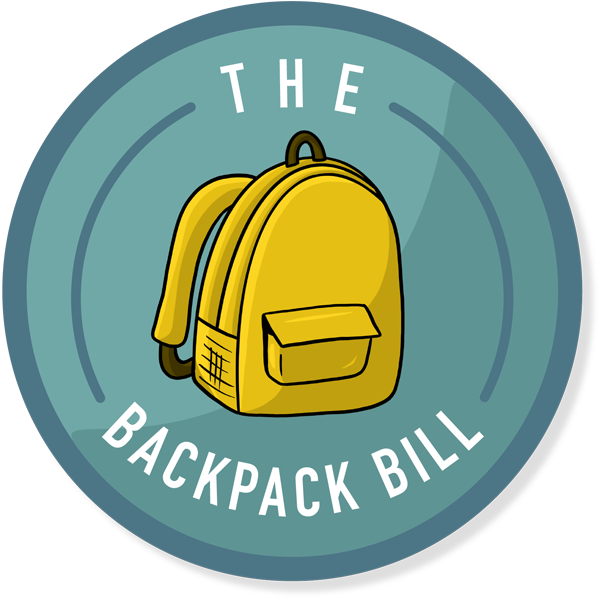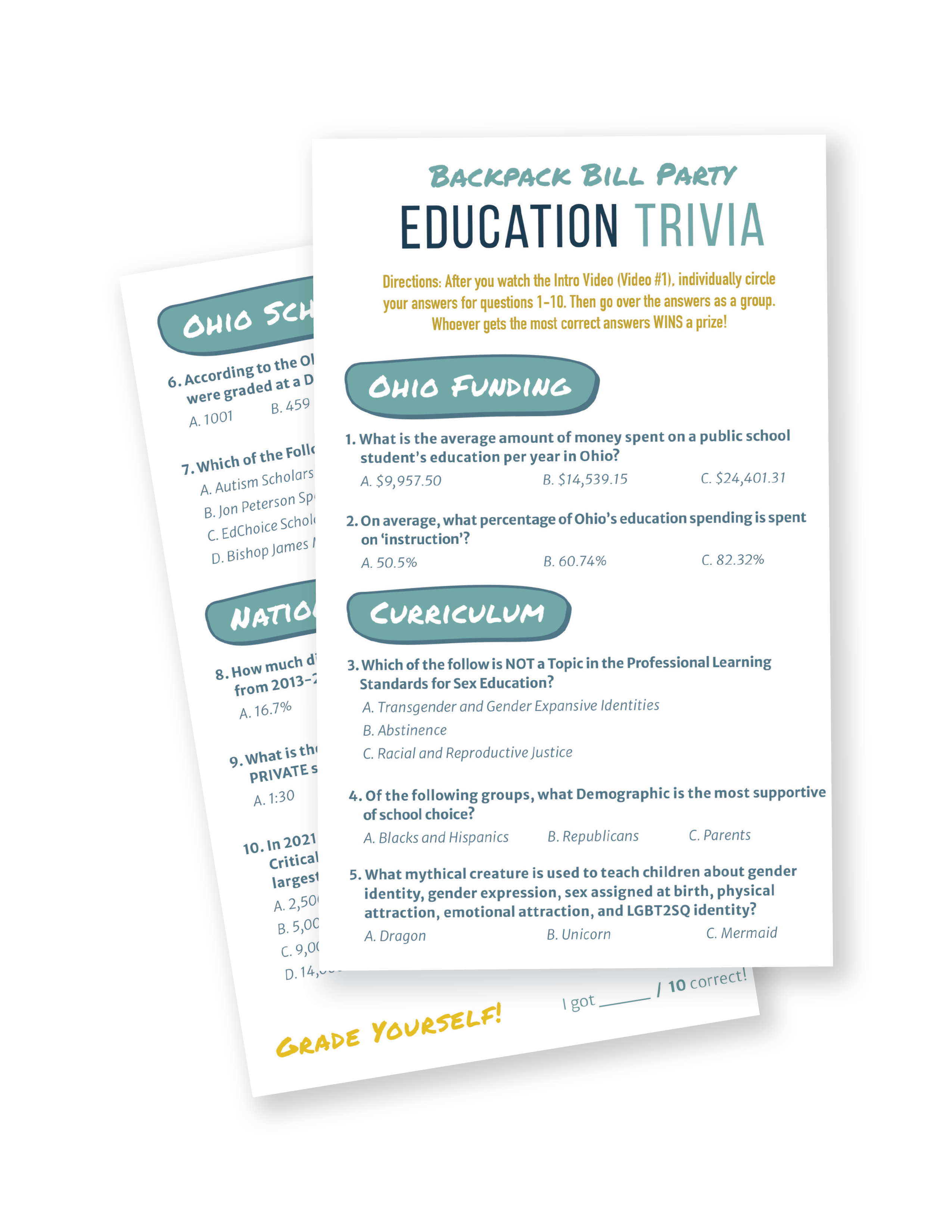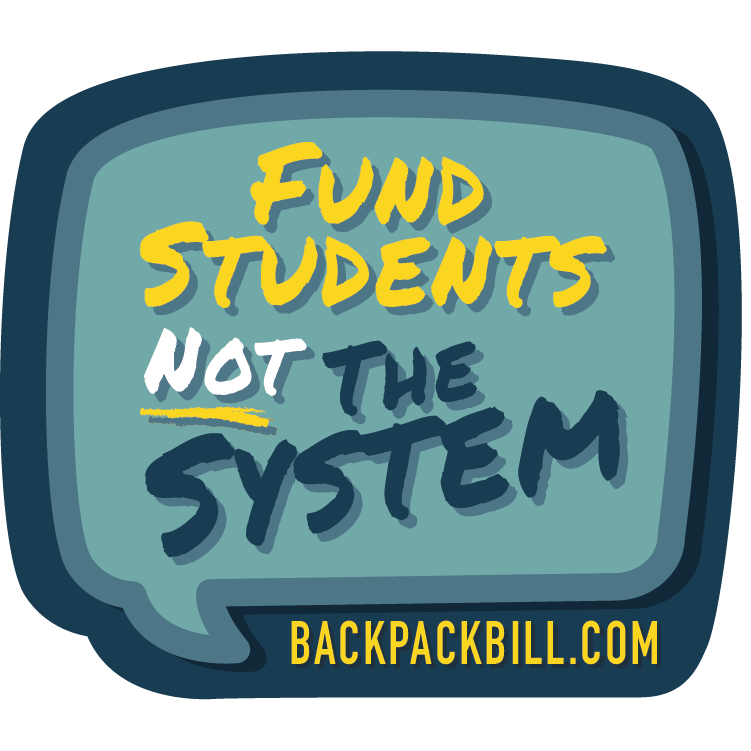DISPELLING Backpack Bill MYTHS
WITH FACTS
Myth 1
The Backpack Bill violates the Ohio Constitution which requires the state to establish “a thorough and efficient system of common schools throughout the state.”
Facts: The Backpack Bill satisfies the constitutional requirement of providing a thorough and efficient system of common schools because it will continue to fund every student in Ohio who chooses to remain in their local public school. In fact, under the Backpack Bill the local public schools will continue to receive not only the state funding allocation for every student who chooses to attend a public school, but also the local tax dollars for every student, including those who choose to matriculate elsewhere through the options provided by the Backpack Bill. The resulting public school system may be smaller, but there is evidence that it would be more thorough and more efficient as the students attending public schools will be students who chose those as the best fit for them. And they will still be funded at a level that is commensurate with their enrollment.
By empowering every parent to make decisions on the family level regarding where to send their child to school, market principles more thoroughly and efficiently spend the dollars available for the education of the state’s students. When parents have multiple options instead of just one, they can determine for themselves which school is the best fit for their child. This is the type of thoroughness and efficiency the state’s educational system needs.


Myth 2
The Backpack Bill violates the Establishment Clause of the U.S. Constitution by providing funding to religious schools.
Facts: The U.S. Supreme Court has ruled on at least two occasions that the types of scholarships Backpack Bill provides are constitutional. In Zelman v. Simmons-Harris (2002), the court upheld the constitutionality of the Cleveland Scholarship Program in Ohio, a forerunner to Backpack Bill. By funding Ohio’s parents to make educational decisions, the fact that some may choose a faith-based option is incidental. Chief Justice Rehnquist wrote in the court’s majority opinion, “The Ohio program is entirely neutral with respect to religion. It provides benefits directly to a wide spectrum of individuals, defined only by financial need and residence in a particular school district. It permits such individuals to exercise genuine choice among options public and private, secular and religious. The program is therefore a program of true private choice.”[1]
This decision was further upheld in Espinoza v. Montana (2020) when the court ruled that religious schools cannot be excluded from a state scholarship program for being religious. Chief Justice Roberts wrote for the Court’s majority, “A state need not subsidize private education. But once a state decides to do so, it cannot disqualify some private schools solely because they are religious.”[2]
Backpack Bill does not fund private schools. It funds parents, who are then free to choose the type of education that best serves their child.
[1] Rehnquist, W. (2002). Majority Opinion of the Court, Zelman v. Simmons-Harris. https://en.wikisource.org/wiki/Zelman_v._Simmons-Harris/Opinion_of_the_Court
[2] Roberts, J. (2020). Majority Opinion of the Court, Espinoza v. Montana. https://www.supremecourt.gov/opinions/19pdf/18-1195_g314.pdf
Myth 3
Facts: The state has allocated approximately $6,200 per pupil for the 2021-22 school year. Under Backpack Bill, public schools will continue to receive every dollar allocated to the students that choose to attend their schools. In addition, public schools continue to receive 100% of local tax revenue earmarked for local public schools, regardless of how many students choose to attend those schools. If students choose to leave their local public school for a school choice option, it actually increases the per pupil funding at the local public school. Some of this increase may be lost to fixed costs such as facilities, but not all of it.
Let’s look at how this works in a school district of 10,000 students in which the district receives the state’s base allocation of $6,200 per student. In addition, each district receives an allocation of local taxes that on average are slightly less than the state allocation, as well as a smaller amount of federal and other funding which are not used in the calculation.[3]
-
-
- 10,000 students x $6,200 (state’s base per pupil allocation) = $62,000,000
- Local tax revenue estimate = $60,000,000
- Total revenue without federal or other contributions = $122,000,000
- Per pupil revenue = $12,200
-
Now, let’s suppose 1,000 of the district’s students use The Backpack Bill scholarship to enroll in a different schooling option that is a better fit. That leaves the district with 9,000 students but the same amount of local tax revenue.
-
-
- 9,000 students x $6,200 = $55,800,000
- Local tax revenue estimate = $60,000,000
- Total revenue without federal or other contributions = $115,800,000
- Per pupil revenue = $12,867
-
As more students leave, the district’s per pupil revenue goes up even more. If we assume 2,000 students use the Backpack Bill scholarship, that leaves 8,000 remaining in the district:
-
-
- 8,000 students x $6,200 = $49,600,000
- Local tax revenue estimate = $60,000,000
- Total revenue without federal or other contribution = $109,600,000
- Per pupil revenue = $13,700
-
Some of the increase in per pupil revenue may be lost in the short-term while the district adjusts its fixed costs such as buildings and infrastructure appropriately. While those may not be immediate adjustments, they could be appropriately sized over time. Short-term adjustments, however, could be made fairly quickly in non-fixed costs such as personnel, student materials, etc. So, while total revenue to districts may decrease as a result of Backpack Bill, the smaller student population also means a larger decrease in expenses.
[3] Fordham Institute (2020). Ohio Education by the Numbers. https://www.ohiobythenumbers.com/#student-enrollment

Myth 4
Facts: Accountability to stakeholders is good and vital to schools staying competitive and performing at a high level. Because public school districts are structured to compel students to attend specific schools based on their residence, those schools have a monopoly on their local population. The monopolies created by binding a large percentage of stakeholder parents and students to a single school require governmental oversight and accountability in the same way that the state uses the Public Utilities Commission of Ohio to regulate and oversee important utility monopolies.
Choice schools like private, charter, and open enrollment public schools, cannot compel attendance or create a monopoly. They operate in a free market and if parents are not satisfied with the performance of the school and with the education their child receives, they will not enroll and the schools will have no student population. Parent satisfaction, and everything that it comprises, is the ultimate test of stakeholder accountability and functions as an even higher level of accountability than the state report card standards because students are free to leave the choice school if they choose. Without Backpack Bill, too many students in Ohio do not have that freedom.
Myth 5
There is no evidence that students who take advantage of school choice programs fare any better as a result.
Facts: Opponents of school choice like to point to studies that show mixed results on academic gains for students who participate in school choice. Researchers at the University of Arkansas looked at 17 different studies measuring the effects of school choice programs on academic gains. Eleven of them showed academic gains for all or some of the participants. Four found no gains and two found very small negative gains.[4] So the overwhelming consensus that the data suggests is that most students benefit, or are at least no worse off academically as a result of choosing their school.
However, the real benefit to school choice is demonstrated in aspects of a student’s education that are not measured by standardized tests. In fact, when given opportunity to name the reasons for choosing a particular school for their child, parents rank test scores near the bottom. Instead, they value highly other important aspects of their child’s development: college attainment, a safe school climate, effective classroom management, better student discipline, better learning environment, smaller class sizes, and more individualized attention for their children.[5] Surveys of parents participating in choice programs show very high levels of satisfaction with these outcomes. According to the Institute for Justice, “Universally, school choice parents are highly satisfied with choice schools, reporting greater discipline, more responsive staff and better educational environments than the public schools they left. That parents are satisfied with their choice schools is a valuable indicator that school choice delivers real benefits. As University of Wisconsin professor John Witte, the official evaluator of the Milwaukee choice program, recently commented on school choice research: ‘There’s one very consistent finding: Parental involvement is very positive, and parental satisfaction is very positive…parents are happier.’”[6]
A study of six major cities, including two in Ohio, that measured parent satisfaction with choice schools vs. non-choice schools showed a vast disparity between satisfaction levels.[7]
Parent Satisfaction Rates in Six Major Cities
| Cleveland | Dayton | Washington, DC | San Antonio | Charlotte | New York | |
| Choice Schools | 50% | 51% | 46% | 61% | 53% | 42% |
| Non-Choice Schools | 30% | 19% | 15% | 35% | 26% | 12% |
Education is highly individualistic and students’ needs vary widely from one student to the next. When parents are given the opportunity to select the school for their child, they are able to find the best situation for each. Their satisfaction rates demonstrate how efficient they are in doing so.
[4] Wolf, P. (2021). The Academic Effects of Private School Choice. https://cpb-us-e1.wpmucdn.com/wordpressua.uark.edu/dist/9/544/files/2018/10/the-academic-effects-of-private-school-choice-summary-of-final-year-results-from-experimental-studies.pdf
[5] Kelly, J. and Scafidi, B. (2013). More Than Scores. http://www.edchoice.org/wp-content/uploads/2015/07/More-Than-Scores.pdf
[6] Institute for Justice (2013). Parental Satisfaction with School Choice. http://www.ij.org/images/pdf_folder/school_choice/parental_satisfaction.pdf#:~:text=Universally%2C%20school%20choice%20parents%20are%20highly%20satisfied%20with,choice%20program%2C%20recently%20commented%20on%20school%20choice%20research%3A
[7] Institute for Justice (2013)

Myth 6
Facts: There is a growing body of research on the effects that school choice programs have on students who choose to remain in their public school. And the results are becoming clear that the effects are positive for all students, but especially those who are economically disadvantaged.
According to a study by the National Bureau of Economic Research, benefits to students remaining in public schools, when those schools have relatively higher levels of choice options, “include higher standardized test scores and lower absenteeism and suspension rates. Effects are particularly pronounced for lower-income students, but results are positive for more affluent students as well.”[8]
Further, these gains can be linked directly to public schools responding to the market pressures that come from the accountability built in to school choice programs. In How Low-Performing Schools Respond to Voucher and Accountability Pressure, researchers demonstrate, “schools facing accountability pressure changed their instructional practices in meaningful ways, and that these responses can explain a portion of the test score gains associated with the Florida school accountability system.” [9]
Finally, an evaluation of Ohio’s own EdChoice Scholarship program leads researchers to conclude, “the weight of the evidence indicates that EdChoice eligibility improved reading and mathematics outcomes for the students affected. We suspect that this is coming through increased competition for lower-ranked public schools as well as a desire for these schools to improve to avoid losing students to the voucher program.” [10]
These are just a few examples on the value of school choice programs for all students. The data shows what you would expect when a free market is allowed to function; students’ families are free to make educational decisions at the most efficient possible level, the individual. Market efficiency forces schools to compete for students which results in incremental improvements that benefit the students for which they are competing. Whether they attend a private school or public school, all students gain from the increased school choice that The Backpack Bill offers.
[8] Figlio, D., Hart, C., Karbownik, K. (2021) Effects of Scaling Up Private School Choice Programs on Public School Students.
[9] Rouse, C., Hannaway, J., Goldhaber, D., and Figlio, D. (2013). Feeling the Florida Heat? How Low-Performing Schools Respond to Voucher and Accountability Pressure. American Economic Journal: Economic Policy, https://dx.doi.org/10.1257/pol.5.2.251
[10] Figlio, D., and Karbownik, K. (2016). Evaluation of Ohio’s EdChoice Scholarship Program: Selection, Competition, and Performance Effects. https://fordhaminstitute.org/sites/default/files/publication/pdfs/FORDHAM-Ed-Choice-Evaluation-Report_online-edition.pdf
Myth 7
Facts: Segregation in schools has a rocky history from racial segregation and forced integration to the anti-Catholic Blaine Amendments. School Choice, however, is not responsible for any current segregation. When schools in the south repealed their compulsory attendance laws and then promptly prohibited black students, it was private Catholic schools who accepted those students.
In Ohio, the racial and socioeconomic differences among districts existed long before EdChoice Scholarships were passed into law in 2005. This segregation is largely due to the way communities are segregated, property taxes are assessed, and districts are drawn.
The demographics of scholarships students within a district are similar to the district at large. Most students who take advantage of an EdChoice Scholarship or live in a qualifying district are a minority race, meaning scholarships largely benefit thousands of minority students. Furthermore, because many scholarship students are minorities, if they attend a predominantly white school or a school in an affluent community they are likely increasing diversity and reducing segregation at that school.[11]
[11] Churchill, Aaron. No, EdChoice is not the cause of racial segregation, Ohio Gadfly Daily (August 12, 2021) https://fordhaminstitute.org/ohio/commentary/no-edchoice-not-cause-racial-segregation


Myth 8
School choice programs have existed in the U.S. for decades. They recently have experienced growth in a number of states as more and more parents, legislators and school leaders become convinced of the benefits. However, school choice programs in Europe have a long and established history, resulting in some of the best performing school systems in the world. Charles Glenn notes that “governments in most Western democracies provide partial or full funding for nongovernment schools chosen by parents; the United States (apart from a few scattered and small-scale programs) is the great exception, along with Greece.”[12] It is worth noting that Greek schools are among the lowest-performing in Europe.
The percentage of students in private schools accepting government funded school choice students is sizable in countries such as Australia (25 percent), Belgium (58 percent), Denmark (11 percent), France (16.8 percent), South Korea (21 percent), the Netherlands (76 percent), Spain (24 percent), and the United Kingdom (30 percent). Of those eight countries, only France scored lower than the United States in the 2018 Programme for International Student Assessment (PISA) rankings.[12]
Every student in Sweden has been granted school choice for the last three decades. The evidence there shows an increase in the share of private school students by 10 percentage points is associated with an improvement of mathematics performance corresponding to about five percentiles in the test score distribution.[13]
Other countries such as Chile, Colombia, and Israel have found benefits to expanding school choice.[14] There is a growing international understanding that bringing competition to the educational marketplace is good for students, which is neither a new, radical, or unproven idea.
[12] Glenn, C. “What the United States Can Learn from Other Countries,” in What America Can Learn from School Choice in Other Countries, ed. David Salisbury and James Tooley (Washington, DC: Cato Institute, 2005), p. 80.
[13] Ahlin, A. Does School Competition Matter? Effects of a Large-Scale School Choice Reform on Student Performance, Uppsala University Department of Economics Working Paper Series, pp. 12-13.
[14] https://www.edchoice.org/school-choice/faqs/how-does-school-choice-work-in-other-countries/
Myth 9
Universal School Choice will only increase tuition at private schools and make the rich richer.
Facts: School Choice already exists for the rich in a way unavailable to low-income families because of their ability to choose where they live and the ability to pay property taxes in whatever district they choose.
Some studies make claims that Universal Choice will increase tuition prices without increasing enrollment.[15] They are quick to note, however, that a true universal choice has never been tested in the United States and that most programs only provide a small subsidy to parents and not an amount equivalent to a full tuition payment.[16] These types of programs would not be enough to help low-income families. The Backpack Bill would provide for full state funding to follow the child and for low-income families not to be up-charged any additional tuition that would hinder their ability to go to private school.
Currently, School Choice in Ohio exists primarily for low-income students, and students in failing schools. Because of this, schools that accept EdChoice Scholarships have to keep tuition and operating costs low to meet a rate that can be sustained by the scholarship amounts. Moreover, private schools cannot charge families that fall below a certain poverty level any additional tuition beyond the scholarship, they cannot even ask a family during the admissions process if they qualify as low-income.
For many religious schools, the mission is more central than the money and if the amount of a Backpack Scholarship is enough to educate a child they will continue to be providers. Additionally, many of these schools have their own financial aid programs in addition to the low-income eligibility parameters put in place by the state.
[15] https://www.chalkbeat.org/2017/7/30/21107261/do-vouchers-actually-expand-school-choice-not-necessarily-it-depends-on-how-they-re-designed
[16] Hungerman, Rinz, Where does Voucher funding go? How large-scale subsidy programs affect private-school revenue, enrollment, and prices, Journal of Public Economics (2016).

Myth 10
Facts: When students with special needs have access to a Backpack Scholarship there will be more opportunities for schools that specialize in intervention. As the market reacts to more school choice and more private schools are started, special needs schools will likely be in the mix to serve that unique demographic of students. Instead of remaining in a public system that may not be the best fit or have all the best resources, parents and students will now have an opportunity to find the right fit.
Jon Peterson and Autism Scholarships aren’t going away. Those students will receive additional funding based on their needs. They could also use a Backpack Scholarship for tools or supplies that would help them in their education beyond what Jon Peterson and the Autism Scholarships provide.
